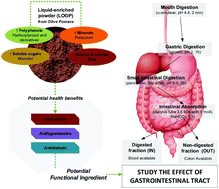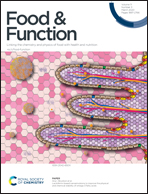Simulated digestion of an olive pomace water-soluble ingredient: relationship between the bioaccessibility of compounds and their potential health benefits
Abstract
Olive pomace is a semisolid by-product with great potential as a source of bioactive compounds. Using its soluble fraction, a liquid-enriched powder (LOPP) was obtained, exhibiting a rich composition in sugars, polyphenols and minerals, with potential antioxidant, antihypertensive and antidiabetic health benefits. To validate the potential of LOPP as a functional ingredient the effect of the gastrointestinal tract on its bioactive composition and bioactivities was examined. Polyphenols and minerals were the most affected compounds; however, a significant bioaccessibility of potassium and hydroxytyrosol was verified (≥57%). As a consequence, the LOPP bioactivities were only moderately affected (losses around 50%). For example, 57.82 ± 1.27% of the recovered antioxidant activity by ORAC was serum-available. From an initial α-glucosidase inhibition activity of 87.11 ± 1.04%, at least 50% of the initial potential was retained (43.82 ± 1.14%). Regarding the initial ACE inhibitory activity (91.98 ± 3.24%), after gastrointestinal tract losses, significant antihypertensive activity was retained in the serum-available fraction (43.4 ± 3.65%). The colon-available fraction also exhibited an abundant composition in phenolics and minerals. LOPP showed to be a potential functional ingredient not only with potential benefits in preventing cardiovascular diseases but also in gut health.



 Please wait while we load your content...
Please wait while we load your content...